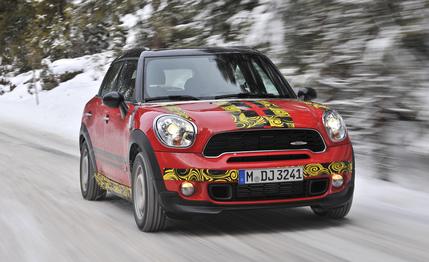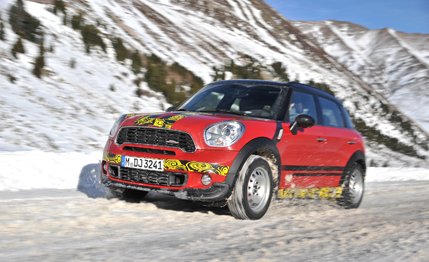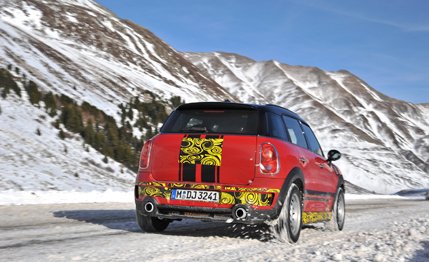 Prototype Drive
Prototype Drive
At the Geneva auto show in March, Mini will unveil the John Cooper Works Countryman. But this week, high in the Austrian Alps, the company gave us the opportunity to try one ahead of its official debut. After flogging it through ice- and snow-bathed roads winding through the mountains, we have good news to report: This is the best Countryman by far, and it may well be the best John Cooper Works Mini.
Something Old, Something New
Much of the John Cooper Works Countryman is carried over directly from the Cooper S Countryman with the Sport package. The ALL4 all-wheel-drive system, which drives the front wheels under normal circumstances but can direct up to 50 percent of the engine’s torque to the rear wheels, is identical here. ALL4 will be the only powertrain offered in the JCW model—unlike lesser Countryman Ss, which are available with front- or all-wheel drive. The Sport-packed Cooper S Countryman already is 0.4 inch lower than the regular Countryman and, as we’ve experienced in our long-termer, rides plenty stiffly. With this in mind, we’re relieved that Mini didn’t give the JCW version an even harsher suspension setup. Our dental plan only covers so many repairs per year for chipped teeth.
A JCW aero kit adds a sportier front fascia and a new rear bumper. The snout is big in person, but when paired with the JCW Countryman’s lower stance, it removes some of the hatchback-on-stilts look of lesser models. Score one for the styling team.

Score one for the powertrain team, too. All versions of the Countryman are heavy; the Cooper S, for instance, weighs 3220 pounds—638 more than a Cooper S hatchback. To give the JCW Countryman performance appropriate for the badge, Mini’s engineers gave the turbocharged 1.6-liter inline-four a shot of espresso. The company is still mum on how much more power and torque were added over the typical JCW output of 208 hp and 207 lb-ft. We figure each number climbs to roughly 220. On the road, the power bump is superbly effective. Although the Cooper S Countryman, with 181 hp and 192 lb-ft, never feels more than peppy, the John Cooper Works delivers the power that a vehicle this size needs to be considered a legitimate hot hatch.
In all the other John Cooper Works cars we’ve driven so far—the traditional hatch (which Mini calls the hardtop), the cabrio, and the coupe—horsepower and torque are almost the nemeses of the driver. Yes, the cars are quick, but their dynamite-in-a-thimble engine abuses the front wheels and tiller. They all suffer from nasty torque steer, and under throttle all they do is understeer.
But pair this engine with Mini's ALL4 system, and those traits disappear. You can rev the 1.6-liter four to high heaven, dump the clutch, and sprint away without the front wheels redirecting the car into a ditch. It makes the Countryman a fabulous handler, too. As in other Minis, the stability and traction control in this Cooper Works are fully defeatable. A sport mode adds some heft to the electric power steering—it’s plenty communicative in its default setting—and remaps the throttle to be a bit more aggressive.
Between allaying torque steer and providing outstanding grip, ALL4 turns the Countryman into a borderline handling hero. In back-to-back driving with its coupe counterpart, the Countryman’s advantage was immediately clear. The coupe struggled to maintain a clean line through tight turns on the slick Alpine roads, sliding wide when it didn’t have traction and, well, torque-steering wide when it did. The JCW Countryman never ran into the same problems, its more neutral behavior making it much easier to keep on line.

Mini’s engineers also tweaked the clutch. (As is the case with other JCW models, a manual is the only available transmission.) Our long-term JCW convertible had a clutch so stiff you needed two feet and a broom to depress the pedal. In contrast, the pedal in the JCW Countryman is very light, meaning driving in stop-and-go traffic won’t be an orthopedic nightmare. The engagement point is a bit higher than that in our long-term Cooper S Countryman, making the pedal easier to modulate. Mini’s engineers explain that this is still meant to be a family car and having a hard clutch and a punishing ride would have been deal breakers. And lest you assume Mini will torpedo the pedal feel of the prototype in the production-spec car, engineering work on the JCW Countryman is almost completed. The only thing Mini has yet to settle is the tuning of the exhaust.
No Groaning, Please
Sales of the Cooper Works Countryman begin in Europe in the first half of 2012 and in the U.S. in the second half of the year. How many Americans will line up at dealerships for their own JCW Countryman is hard to say. Mini hasn’t even hinted at pricing yet, but with most JCW models commanding a 20-to-30-percent premium over their Cooper S equivalents, the Countryman won’t be cheap. The Cooper S Countryman ALL4 runs $27,750 to start, so we’re guessing on a base sticker of about $36,000 for the JCW version.
Yes, 36 grand is a lot of money for a Mini. But the average transaction price on a Mini is already high, and people routinely spend $30,000 on loaded versions of the 121-hp Mini Cooper hatchback. Besides, Mini’s customer research shows that loads of its buyers could afford much more expensive vehicles; perhaps $36,000 won’t sting so much when the alternative is another BMW or Audi for $50,000 or more.